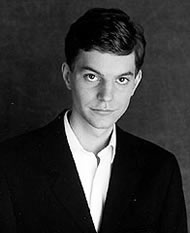 In 2004, Austrian pianist Till Fellner (already known internationally at that point) made waves by releasing an extraordinary recording of the first book of Bach's Well-Tempered Clavier. A year after that, still riding a swell of concert appearances and the long-time support of none other than Alfred Brendel, the 30-something Fellner (b. 1972) cancelled a concert at Lincoln Center and several others after that. The reason was the appearance of a mysterious medical condition, as described by David Mermelstein in the New York Times (Hearing Things. The Wrong Kind of Things., January 28). Fellner had suddenly developed an irritating sensitivity to loud sounds, part of a set of symptoms collectively known as tinnitus, usually a result of damage to the inner ear. After three months of rest and treatment, his hearing appears to have returned to normal. Last week, Fellner played a recital program, first at the Metropolitan Museum of Art in New York and on Sunday evening on the free concert series at the National Gallery of Art.
In 2004, Austrian pianist Till Fellner (already known internationally at that point) made waves by releasing an extraordinary recording of the first book of Bach's Well-Tempered Clavier. A year after that, still riding a swell of concert appearances and the long-time support of none other than Alfred Brendel, the 30-something Fellner (b. 1972) cancelled a concert at Lincoln Center and several others after that. The reason was the appearance of a mysterious medical condition, as described by David Mermelstein in the New York Times (Hearing Things. The Wrong Kind of Things., January 28). Fellner had suddenly developed an irritating sensitivity to loud sounds, part of a set of symptoms collectively known as tinnitus, usually a result of damage to the inner ear. After three months of rest and treatment, his hearing appears to have returned to normal. Last week, Fellner played a recital program, first at the Metropolitan Museum of Art in New York and on Sunday evening on the free concert series at the National Gallery of Art.Anthony Tommasini, A Pianist Returns, a Little Bit Shy, a Little Bit Sly (New York Times, February 10) Jay Nordlinger, A Musician Who Knows His Mind (New York Sun, February 12) Cecelia Porter, Till Fellner (Washington Post, February 13) |
| Till Fellner on Disc: Bach, WTC, Book 1 (2004) Beethoven, Piano Concerto 3 (2003) Schubert, Moments musicaux, Sonata D. 784 (1997) |
Fellner seemed to love no. 11 the most, phrasing it with exquisite delicacy, and no. 13, where an uncharacteristic smile stole across his usually serious face, over an unexpected turn of melody. He allows Bach's music to unfold at its own pace, without distorting it rhythmically, giving subtle nuance to the layering of voices, as in no. 15, with the bubbling repeated notes of the main theme over the zephyr of an arpeggiated countersubject. Fellner does not underuse the sustaining pedal, it's true, but the test is in the sound, and there was nothing muddy. The sound was clear, if never dry.
Schubert's A major sonata (D. 959, finished shortly before the composer's death in 1828) concluded the program. In the Bach Fellner's sound was notably restrained, an internal dialogue, but in the Schubert he used more heroic strength. This interpretation was so refined, so smart, making the sonata-allegro form of the first movement so clear, opposing a forthright first theme with a gossamer-delicate second theme. The second movement was a melancholy parlor dance, heard from a distant room. Fellner did the best he could with that fantasia-like second section -- Schubert seemed almost out of ideas, taking the performer through a quasi-improvisatory pile-up of arpeggios.
The third movement whirled away, detached from the dying composer's fear of impending death, with the triplet cascades a perfect torrent at Fellner's tempo. In the trio, he handled the difficult crossing of the left hand with flair and taste. One thing about Fellner's touch is that it makes sense of the ultrahigh writing that Schubert so often favors: here it sounded like ethereal decoration, whereas if overplayed, it can be strident. In the fourth movement, Fellner treated the rondo theme like a hymn, in an easy rocking tempo, which comes back in minor in the most overt reference Schubert makes to the unstoppable progress of his illness. It was regrettable that the audience at this free concert was so poorly behaved -- enough shoe squeaking, coughing, and cell phone noise to make Fellner actually look out at the audience in distraction a couple times. This excellent recital deserved the attention level of the audience at the Emerson Quartet's Shostakovich concerts.
In conjunction with the National Gallery of Art's Jasper Johns exhibit, the museum devotes the next three weeks of its free concert series to the Sixty-Second American Music Festival: violinist Mark Kaplan and pianist Yael Weiss (February 18, music by Carter, Feigin, and Sessions), pianist Alan Feinberg (February 25, music by Beiderbecke, Cage, Feldman, Ives, and Nancarrow), and the Contemporary Music Forum (March 4, music by Cage and others). All concerts begin at 6:30 pm and are free and open to the public.
This is a lovely review.
ReplyDeleteMarc, thanks for the kind words. It means a lot to me. All best!
ReplyDeleteAnd it's a splendid blog too.
ReplyDeleteSay, is there a site that does for NYC what you fine folks do for DC?
Teju, there are plenty of fine blogs on music and the arts in NYC, but I'm not sure that there is something quite like Ionarts there. Thanks for the nice comment!
ReplyDelete